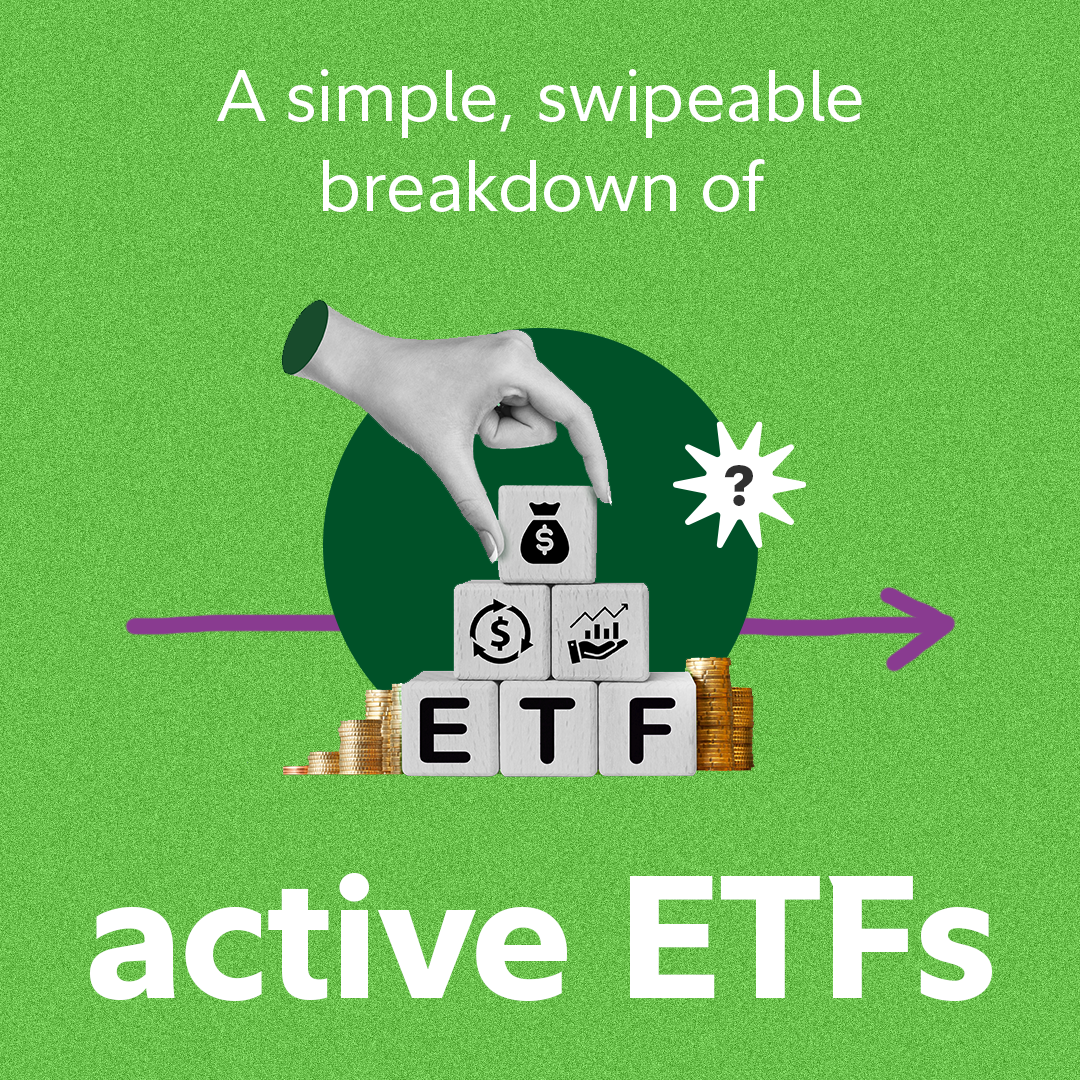This information is intended to be educational and is not tailored to the investment needs of any specific investor.
Fidelity is not affiliated with Instagram or the Instagram service. Fidelity does not expressly or implicitly adopt or endo any of the expressions, opinions or content posted by followers or any third parties on our Instagram channel. Fidelity does not control, serve, adopt or endorse any advertising, messages or content that Instagram may publish on its site or on Fidelity's Instagram channel. Fidelity does not adopt or endorse any products, services, advertisements, recommendations or statements, or any other content that may appear on Instagram or on other Instagram-affiliated sites. No part of our Instagram channel is intended to make a recommendation or state a testimonial for or about a security, service or product, or to provide investment, tax or any other advice.
Other Fidelity entities may also publish content on Fidelity's Instagram channel.
IMPORTANT: Our customer care reps will do their best to answer your questions. Questions related to our brokerage offerings or your brokerage account will be answered by a representative of Fidelity Brokerage Services LLC and will identified by the handle "Fidelity" followed by the first name of the representative, e.g. "FidelityMike".
CRYPTO: Certain questions specific to crypto or your Fidelity Crypto® account offered by Fidelity Digital Assets® will be answered by representatives of Fidelity Digital Assets and identified by the handle "Fidelity Crypto®" followed by the first name of the representative, e.g. "FidelityCryptoMike". Fidelity Crypto® is offered by Fidelity Digital Assets®.
Fidelity Crypto® is offered by Fidelity Digital Assets®.
Investing involves risk, including risk of total loss.
Crypto as an asset class is highly volatile, can become illiquid at any time, and is for investors with a high risk tolerance. Crypto may also be more susceptible to market manipulation than securities. Crypto is not insured by the Federal Deposit Insurance Corporation, the Securities Investor Protection Corporation, or any other government agency, and is not an obligation of any bank. Investors in crypto do not benefit from the same regulatory protections applicable to registered securities.
Fidelity Crypto® accounts and custody and trading of crypto in such accounts are provided by Fidelity Digital Assets, National Association, which is a national trust bank.
Brokerage services in support of securities trading are provided by Fidelity Brokerage Services LLC (“FBS”), and related custody services are provided by National Financial Services LLC (“NFS”), each a registered broker-dealer and member NYSE and SIPC.
Neither FBS nor NFS offer crypto as a direct investment nor provide trading or custody services for such assets.
Fidelity Crypto and Fidelity Digital Assets are registered service marks of FMR LLC.
Digital assets as an asset class are highly volatile, can become illiquid at any time, and are for investors with a high risk tolerance. Digital assets may also be more susceptible to market manipulation than securities. Digital assets are not insured by the Federal Deposit Insurance Corporation. Investors in digital assets do not benefit from the same regulatory protections applicable to registered securities.
Fidelity Brokerage Services LLC does not offer crypto as a direct investment nor provide trading or custody services for such assets.
Investing Disclaimers:
Investing involves risk, including risk of loss.
Be sure to consider all your available options and the applicable fees and features of each before moving your retirement assets.
Investment decisions should be based on an individual’s own goals, time horizon, and tolerance for risk.
ETFs are subject to market fluctuation and the risks of their underlying investments. ETFs are subject to management fees and other expenses.
Exchange-traded products (ETPs) are subject to market volatility and the risks of their underlying securities, which may include the risks associated with investing in smaller companies, foreign securities, commodities, and fixed income investments. Foreign securities are subject to interest rate, currency exchange rate, economic, and political risks, all of which are magnified in emerging markets. ETPs that target a small universe of securities, such as a specific region or market sector, are generally subject to greater market volatility, as well as to the specific risks associated with that sector, region, or other focus. ETPs that use derivatives, leverage, or complex investment strategies are subject to additional risks. The return of an index ETP is usually different from that of the index it tracks because of fees, expenses, and tracking error. An ETP may trade at a premium or discount to its net asset value (NAV) (or indicative value in the case of exchange-traded notes). The degree of liquidity can vary significantly from one ETP to another and losses may be magnified if no liquid market exists for the ETP's shares when attempting to sell them. Each ETP has a unique risk profile, detailed in its prospectus, offering circular, or similar material, which should be considered carefully when making investment decisions.
Annuity guarantees are subject to the claims-paying ability of the issuing insurance company.
Options trading entails significant risk and is not appropriate for all investors. Certain complex options strategies carry additional risk. Before trading options, please read . Supporting documentation for any claims, if applicable, will be furnished upon request.
Past performance is no guarantee of future results.
Fidelity Go® provides discretionary investment management, and in certain circumstances, non-discretionary financial planning, for a fee. Advisory services offered by Strategic Advisers LLC (Strategic Advisers), a registered investment adviser. Brokerage services provided by Fidelity Brokerage Services LLC (FBS), and custodial and related services provided by National Financial Services LLC (NFS), each a member NYSE and SIPC. Strategic Advisers, FBS and NFS are Fidelity Investments companies.
Brokerage services provided by Fidelity Brokerage Services LLC (FBS), and custodial and related services provided by National Financial Services LLC (NFS), each a member NYSE and SIPC. Strategic Advisers, FBS, and NFS are Fidelity Investments companies.
Diversification and asset allocation do not ensure a profit or guarantee against loss.
Trading penny stocks may pose greater risk than trading stocks on larger exchanges. These risks may include a lack of public information about the company, no minimum listing standards for the exchange they are traded on, low liquidity, high volatility and penny stocks are more susceptible to fraudulent activity.
Target Date Funds are an asset mix of stocks, bonds and other investments that automatically becomes more conservative as the fund approaches its target retirement date and beyond. Principal invested is not guaranteed.
Stop loss orders do not guarantee the execution price you will receive and have additional risks that may be compounded in periods of market volatility. Stop loss orders could be triggered by price swings and could result in an execution well below your trigger price.
Fractional share quantities can be entered out to 3 decimal places (.001) as long as the value of the order is at least $1.00. Dollar-based trades can be entered out to 2 decimal places (e.g. $250.00).
The S&P 500 Index is a market capitalization-weighted index of 500 common stocks chosen for market size, liquidity, and industry group representation to represent US equity performance.
Dow Jones US Completion Total Stock Market Index is a float-adjusted market capitalization–weighted index of all equity securities of US headquartered companies with readily available price data, except those included in the S&P 500 Index.
Nasdaq-100 Index includes 100 of the largest non-financial companies listed on the NASDAQ Stock Market based on market capitalization.
Indexes are unmanaged. It is not possible to invest directly in an index.
How we got these numbers:
* Approximation based on a 1% increase in contribution rate. Continued employment from current age to retirement age, 67. We assume you are exactly your current age (in whole number of years) and will retire on your birthday at your retirement age. Number of years of savings equals retirement age minus current age. Nominal investment growth rate is assumed to be 5.5%. Hypothetical nominal salary growth rate is assumed to be 4% (2.5% inflation + 1.5% real salary growth rate). All accumulated retirement savings amounts are shown in future (nominal) dollars. This assumes no loans or withdrawals are taken throughout the current age to retirement age. Your own plan account may earn more or less than this example and income taxes will be due when you withdraw from your account. Investing in this manner does not ensure a profit or guarantee against a loss in declining markets. Investing involves risk, including the risk of loss.
10X Methodology
Fidelity has developed a series of salary multipliers in order to provide participants with one measure of how their current retirement savings might be compared to potential income needs in retirement. The salary multiplier suggested is based solely on your current age. In developing the series of salary multipliers corresponding to age, Fidelity assumed age-based asset allocations consistent with the equity glide path of a typical target date retirement fund, a 15% savings rate, a 1.5% constant real wage growth, a retirement age of 67 and a planning age through 93. The replacement annual income target is defined as 45% of pre-retirement annual income and assumes no pension income. This target is based on Consumer Expenditure Survey (BLS), Statistics of Income Tax Stat, IRS tax brackets and Social Security Benefit Calculators. Fidelity developed the salary multipliers through multiple market simulations based on historical market data, assuming poor market conditions to support a 90% confidence level of success.
These simulations take into account the volatility that a typical target date asset allocation might experience under different market conditions. Volatility of the stocks, bonds and short-term asset classes is based on the historical annual data from 1926 through the most recent year-end data available from Ibbotson Associates, Inc. Stocks (domestic and foreign) are represented by Ibbotson Associates SBBI S&P 500 Total Return Index, bonds are represented by Ibbotson Associates SBBI U.S. Intermediate Term Government Bonds Total Return Index, and short term are represented by Ibbotson Associates SBBI 30-day U.S. Treasury Bills Total Return Index, respectively. It is not possible to invest directly in an index. All indices include reinvestment of dividends and interest income. All calculations are purely hypothetical and a suggested salary multiplier is not a guarantee of future results; it does not reflect the return of any particular investment or take into consideration the composition of a participant’s particular account. The salary multiplier is intended only to be one source of information that may help you assess your retirement income needs. Remember, past performance is no guarantee of future results. Performance returns for actual investments will generally be reduced by fees or expenses not reflected in these hypothetical calculations. Returns also will generally be reduced by taxes.
Other important information:
Fidelity does not provide legal or tax advice. The information herein is general in nature and should not be considered legal or tax advice. Consult an attorney or tax professional regarding your specific situation.
Generally, among asset classes stocks are more volatile than bonds or short-term instruments and can decline significantly in response to adverse issuer, political, regulatory, market, or economic developments. Although the bond market is also volatile, lower-quality debt securities including leveraged loans generally offer higher yields compared to investment grade securities, but also involve greater risk of default or price changes. Foreign markets can be more volatile than U.S. markets due to increased risks of adverse issuer, political, market or economic developments, all of which are magnified in emerging markets.
For a distribution to be considered qualified, the 5-year aging requirement has to be satisfied, and you must be age 59½ or older or meet one of several exemptions (disability, qualified first-time home purchase, or death among them).
For 2025, eligibility for a full Roth IRA contribution is available to joint filers whose 2025 Modified Adjusted Gross Income (MAGI) is $236,000 or less ($236,000-$246,000 is eligible for a partial contribution). For single filers, full eligibility is available to those whose 2025 MAGI is $150,000 or less ($150,000-$165,000 is eligible for a partial contribution).
For 2026, eligibility for a full Roth IRA contribution is available to joint filers whose 2026 MAGI is $242,000 or less ($242,000-$252,000 is eligible for a partial contribution). For single filers, full eligibility is available to those whose 2026 MAGI is $153,000 or less ($153,000-$168,000 is eligible for a partial contribution).
Fidelity Stock Plan Services, LLC, provides recordkeeping and/or administrative services to your company's equity compensation plan, in addition to any services provided directly to the plan by your company or its service providers.
The information provided here is general in nature. It is not intended, nor should it be construed, as legal or tax advice. Because the administration of an HSA is a taxpayer responsibility, customers should be strongly encouraged to consult their tax advisor before opening an HSA. Customers are also encouraged to review information available from the Internal Revenue Service (IRS) for taxpayers, which can be found on the IRS Web site at www.IRS.gov. They can find IRS Publication 969, Health Savings Accounts and Other Tax-Favored Health Plans, and IRS Publication 502, Medical and Dental Expenses (including the Health Coverage Tax Credit),online, or you can call the IRS to request a copy of each at 800.829.3676.
With respect to federal taxation only. Contributions, investment earnings, and distributions may or may not be subject to state taxation.
The new beneficiary must be an eligible family member of the original beneficiary to avoid federal income taxes and the 10% federal penalty. A family member is a person who has one of the following relationships with the original beneficiary: (1) son or daughter; (2) stepson or stepdaughter; (3) brother, sister, stepbrother, or stepsister; (4) father, mother, or an ancestor of either; (5) stepfather or stepmother; (6) son or daughter of a brother or sister; (7) brother or sister of a father or mother; (8) son or daughter-in-law, father or mother-in-law, brother or sister-in-law; (9) spouses of the individuals listed in (1)–(8) or the spouse of the beneficiary; and (10) any first cousin. Note that a new account will be required in order to change the beneficiary.
Solutions offered by Active Trader Services are available to investors in households that place 120 or more stock, bond, or options trades in a rolling 12-month period and maintain $250K in assets across their eligible Fidelity brokerage accounts.
529s:
529 distributions for qualified education expenses are generally federal income tax free. 529 assets may be used to pay for (i) qualified higher education expenses, (ii) qualified expenses for registered apprenticeship programs, (iii) up to $10,000 per taxable year per beneficiary for tuition expenses ($20,000 for expenses beginning in taxable years after December 31, 2025) in connection with enrollment at a public, private, and religious elementary and secondary educational institution. Although such assets may come from multiple 529 accounts, the $10,000 qualified withdrawal ($20,000 beginning in taxable years after December 31, 2025) limit will be aggregated on a per beneficiary basis. The IRS has not provided guidance to date on the methodology of allocating the $10,000 annual maximum ($20,000 beginning in taxable years after December 31, 2025) among withdrawals from different 529 accounts, (iv) amounts paid as principal or interest on any qualified education loan of a 529 plan designated beneficiary or a sibling of the designated beneficiary. The amount treated as a qualified expense is subject to a lifetime limit of $10,000 per individual. Although the assets may come from multiple 529 accounts, the $10,000 withdrawal limit for qualified educational loans payments will be aggregated on a per individual basis. The IRS has not provided guidance to date on the methodology of allocating the $10,000 annual maximum among withdrawals from different 529 accounts, and (v) tuition, fees, books, supplies, and equipment required for the enrollment or attendance in a recognized postsecondary credential program as defined under Section 529 of the Code and identified by the Secretary of the Treasury as being such a reputable program.
Any earnings on distributions not used for qualified higher educational expenses or that exceed distribution limits may be taxed as ordinary income and may be subject to a 10% federal tax penalty. Some states do not conform with federal tax law. Please check with your home state to determine if it recognizes the expanded 529 benefits afforded under federal tax law, including distributions for elementary and secondary education expenses, apprenticeship programs, postsecondary credentialing programs, and student loan repayments. You may want to consult with a tax professional before investing or making distributions.
Beginning January 2024, the Secure 2.0 Act of 2022 (the "Act") provides that you may transfer assets from your 529 account to a Roth IRA established for the Designated Beneficiary of a 529 account under the following conditions: (i) the 529 account must be maintained for the Designated Beneficiary for at least 15 years, (ii) the transfer amount must come from contributions made to the 529 account at least five years prior to the 529-to-Roth IRA transfer date, (iii) the Roth IRA must be established in the name of the Designated Beneficiary of the 529 account, (iv) the amount transferred to a Roth IRA is limited to the annual Roth IRA contribution limit, and (v) the aggregate amount transferred from a 529 account to a Roth IRA may not exceed $35,000 per individual. It is your responsibility to maintain adequate records and documentation on your accounts to ensure you comply with the 529-to-Roth IRA transfer requirements set forth in the Internal Revenue Code. The Internal Revenue Service (“IRS”) has not issued guidance on the 529-to-Roth IRA transfer provision in the Act but is anticipated to do so in the future. Based on forthcoming guidance, it may be necessary to change or modify some 529-to-Roth IRA transfer requirements. Please consult a financial or tax professional regarding your specific circumstances before making any investment decision.
An accelerated transfer to a 529 plan (for a given beneficiary) of $95,000 (or $190,000 combined for spouses who gift split) will not result in federal transfer tax or use of any portion of the applicable federal transfer tax exemption and/or credit amounts if no further annual exclusion gifts and/or generation-skipping transfers to the same beneficiary are made over the five-year period and if the transfer is reported as a series of five equal annual transfers on Form 709, United States Gift (and Generation-Skipping Transfer) Tax Return. If the donor dies within the five-year period, a portion of the transferred amount will be included in the donor's estate for estate tax purposes.
Any non-Fidelity URLs or external websites mentioned on Instagram channel are unaffiliated with Fidelity. Fidelity has been involved in the preparation of the content supplied at the unaffiliated sites and does not guarantee or assume responsibility for its content.
The trademarks and/or service marks appearing above are the property of FMR LLC and may be registered.
The third-party trademarks and service marks appearing herein are the property of their respective owners.
Stock markets are volatile and can fluctuate significantly in response to company, industry, political, regulatory, market, or economic developments. Investing in stock involves risks, including the loss of principal.
Investing in bonds involves risk, including interest rate risk, inflation risk, credit and default risk, call risk, and liquidity risk.
Foreign markets can be more volatile than U.S. markets due to increased risks of adverse issuer, political, market, or economic developments, all of which are magnified in emerging markets. These risks are particularly significant for investments that focus on a single country or region.
Before investing, consider the investment objectives, risks, charges, and expenses of the mutual fund, exchange-traded fund, 529 plan, Attainable Savings Plan, or annuity and its investment options. Contact Fidelity for a prospectus, offering circular, Fact Kit, disclosure document, or, if available, a summary prospectus containing this information. Read it carefully.
Fidelity Brokerage Services LLC, Member NYSE, SIPC, 900 Salem Street, Smithfield, RI 02917
© 2019 FMR LLC. All rights reserved.













































